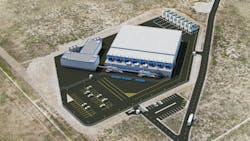INNIO and VoltaGrid: Landmark 2.3 GW Modular Power Deal Signals New Phase for AI Data Centers
Key Highlights
- INNIO's 2.3 GW modular power system supports one of the world's largest data centers, emphasizing efficiency and rapid transient response for AI workloads.
- The project utilizes innovative, battery-free technology designed to smooth AI load swings and meet stringent emissions standards, including hydrogen readiness.
- Collaborations with VoltaGrid, Oracle, ABB, and Halliburton demonstrate a comprehensive approach to scalable, sustainable, and grid-compatible data center power solutions.
- The deployment model allows phased energization, reducing interconnection delays and aligning power availability with data center construction schedules.
- This initiative signals a shift toward 'prime-as-infrastructure,' establishing a new template for gigawatt-scale AI data center power resilience.
INNIO Group announced it has secured the largest order by power delivery in its history: 2.3 GW of modular generation capacity, comprising 92 power packs of approximately 25 MW each. The units will support one of the world’s largest data centers, in collaboration with VoltaGrid.
The project centers on Jenbacher-based, fast-ramping, high-efficiency natural-gas systems designed to deliver prime, backup, and peak power from a single platform. INNIO cites key performance benchmarks including sustained output at ambient temperatures up to 50 °C (122 °F), superior transient response to accommodate volatile AI loads, and efficiency up to 10 percentage points higher than competing alternatives, translating to more than $300 million in modeled annual fuel savings at the full 2.3 GW scale.
Dr. Olaf Berlien, President and CEO of INNIO Group, described the contract as a “landmark order,” saying:
This landmark order underscores the strength of INNIO’s technology and our ability to power the AI revolution with smart, high-performance energy solutions. We are proud to partner with VoltaGrid in shaping the energy infrastructure of tomorrow.
VoltaGrid and Oracle: Scaling AI Power Without Batteries
Notably, VoltaGrid has separately announced plans to deploy 2.3 GW of ultra-low-emissions infrastructure for Oracle Cloud Infrastructure (OCI). The system will be supplied by Energy Transfer’s pipeline and storage network and built with key suppliers INNIO Jenbacher and ABB. Engineered for zero reliance on battery storage, the platform is designed to smooth the sharp power swings created by AI training loads while maintaining grid-grade reliability.
That positioning places this INNIO order squarely within the context of Oracle’s accelerating AI expansion.
Nathan Ough, CEO of VoltaGrid, described the partnership this way:
This is a major step toward building the energy infrastructure for the AI era. Together with INNIO, we’re delivering a scalable solution that combines grid-grade performance with ultra-fast response, zero battery reliance, and near-zero criteria air emissions. Our partnership provides the speed, reliability, and sustainability required to power next-generation data centers.
Why This Project Marks a Landmark Shift
The deployment of 2.3 GW of modular generation represents utility-scale capacity, but what makes it distinct is the delivery model. Instead of a centralized plant, the project uses modular gas-reciprocating “power packs” that can be phased in step with data-hall readiness. This approach allows staged energization and limits the bottlenecks that often stall AI campuses as they outgrow grid timelines or wait in interconnection queues.
AI training loads fluctuate sharply, placing exceptional stress on grid stability and voltage quality. The INNIO/VoltaGrid platform was engineered specifically for these GPU-driven dynamics, emphasizing high transient performance (rapid load acceptance) and grid-grade power quality, all without dependence on batteries.
Each power pack is also designed for maximum permitting efficiency and sustainability. Compared with diesel generation, modern gas-reciprocating systems materially reduce both criteria pollutants and CO₂ emissions. VoltaGrid markets the configuration as near-zero criteria air emissions and hydrogen-ready, extending allowable runtimes under air permits and making “prime-as-a-service” viable even in constrained or non-attainment markets.
2025: Momentum for Modular Prime Power
INNIO has spent 2025 positioning its Jenbacher platform as a next-generation power solution for data centers: combining fast start, high transient performance, and lower emissions compared with diesel. While the 3 MW J620 fast-start lineage dates back to 2019, this year the company sharpened its data center narrative and booked grid stability and peaking projects in markets where rapid data center growth is stressing local grids. This momentum was exemplified by an 80 MW deployment in Indonesia announced earlier in October.
The same year saw surging AI-driven demand and INNIO’s growing push into North American data-center markets. Specifications for the 2.3 GW VoltaGrid package highlight the platform’s heat tolerance, efficiency, and transient response, all key attributes for powering modern AI campuses.
VoltaGrid’s 2025 Milestones
VoltaGrid’s announcements across 2025 reflect rapid market validation for its modular power approach:
- Jan 16: Launched QPac, a joint platform with INNIO Jenbacher featuring reciprocating-engine nodes up to 20 MW each, stackable to 200 MW under a minor-source air permit: a crucial regulatory lever. QPac is tuned for high-pressure gas mixing and AI-class load acceptance, hydrogen-ready, and operates below 65 dBA at 10 m.
- Feb 11: Signed a framework agreement with Vantage Data Centers to deploy more than 1 GW of prime generation across constrained North American markets — validating demand from a top-tier hyperscale developer and proving VoltaGrid can deliver at gigawatt scale.
- Oct 15: Announced collaboration with Oracle Cloud Infrastructure to deliver 2.3 GW using Energy Transfer’s firm gas, with INNIO Jenbacher and ABB as core suppliers. Messaging centered on damping AI load swings without batteries and ensuring mission-critical power quality. While not explicitly named, this is almost certainly the same 2.3 GW program referenced in INNIO’s announcement.
- Oct 20–22: Revealed a strategic collaboration with Halliburton to globalize deployment and operations for data-center power projects — leveraging Halliburton’s field-execution machine for scalability. Trade coverage indicates an initial Middle East rollout, adding the operational muscle needed to replicate the model internationally.
ABB’s Role in Building Grid-Quality Modular Power
ABB has been identified by VoltaGrid as a key technology supplier for the Oracle Cloud Infrastructure (OCI) platform; providing power electronics, controls, switchgear, and protection systems.
Combined with INNIO’s Jenbacher generation stack, ABB’s contribution is central to delivering grid-quality, fast-response power capable of riding through AI load transients and meeting hyperscaler reliability standards.
Future Implications for AI Campus Development
Large AI campuses, particularly across ERCOT and other high-growth regions, face multi-year interconnection and upgrade delays. A 2.3 GW modular prime fleet provides construction-aligned capacity, allowing compute operations to come online in sync with building completion, rather than waiting for grid availability.
INNIO’s efficiency advantage and VoltaGrid’s battery-free architecture are designed to reduce both capex and opex while maintaining transient performance and power quality. If the projected $300 million in annual fuel savings proves accurate, it could significantly offset the cost of prime generation compared with grid-connection delays.
Meanwhile, the QPac platform’s “up to 200 MW under a minor-source air permit” model presents a scalable playbook for site-by-site deployment. This approach accelerates permitting while staying within local emission thresholds, an increasingly valuable tactic as counties tighten diesel restrictions and impose environmental offset requirements.
So What’s the Bottom Line?
INNIO’s 2.3 GW order with VoltaGrid stands as the clearest signal yet that hyperscale AI operators are normalizing “prime-as-infrastructure” — not as a temporary stopgap, but as a core architectural layer for capacity, stability, and schedule control.
The 2025 progression — from the QPac launch with INNIO, to the >1 GW Vantage framework, to OCI’s 2.3 GW firm-gas collaboration with Energy Transfer, and finally Halliburton’s entry to globalize deployment — establishes a repeatable template for gigawatt-scale buildouts.
For AI factories racing ahead of grid build-outs, this model offers a practical and immediate pathway to capacity, defining a new playbook for power resilience in the AI era.
At Data Center Frontier, we talk the industry talk and walk the industry walk. In that spirit, DCF Staff members may occasionally use AI tools to assist with content. Elements of this article were created with help from OpenAI's GPT5.
Keep pace with the fast-moving world of data centers and cloud computing by connecting with Data Center Frontier on LinkedIn, following us on X/Twitter and Facebook, as well as on BlueSky, and signing up for our weekly newsletters using the form below.
About the Author




